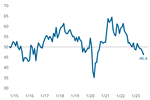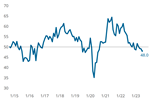Composites industry saw stabilized contraction in October
The GBI: Composites Fabricating index has contracted for the seventh month in a row, with one notable change in component activity.
Moving away from 50. GBI: Composites Fabricating in October was down 0.3 point relative to September. Photo credit, all images: Gardner Intelligence
The GBI: Composites Fabricating in October continued its path of contraction at a rate in line with September, marking 7 months straight of contraction. The overall index reached 45.6, down 0.3 points from 45.9 the previous month.
With one exception, components leveled out or changed minimally in October while remaining in contraction phase. The largest component index increase was backlog, up 0.34 points, and the largest index decline was exports, down 0.38 points.
October outliers. Backlog and new orders did not move in parallel as is common, backlog being the likely outlier with slightly slowed contraction in October. (This graph reports on a three-month moving average.)
The backlog component’s slight increase is not accompanied by an increase in new orders, as might be expected, and the production metric is “flat.” This all suggests slowed backlog contraction may actually not be occurring, and if it is, will be short-lived.
Supplier deliveries continued lengthening, but at a slower rate that landed it closer to flat than supplier deliveries has been since January 2020, potentially a sign that business is slow.
Related Content
-
Composites Fabricating Index reaches expansion at 50.3
First reading of 2025 breaks 21-month contraction run behind broad-based component growth.
-
Composites industry activity meaningfully slowed contraction in March
The GBI: Composites Fabricating still contracted in March, though it landed just one point shy of 50, which could eventually lead it into expansion territory.
-
Composites Fabricating Index continues positive position
Little change is good news for the composites market, which held steady in expansion during the month of July.



